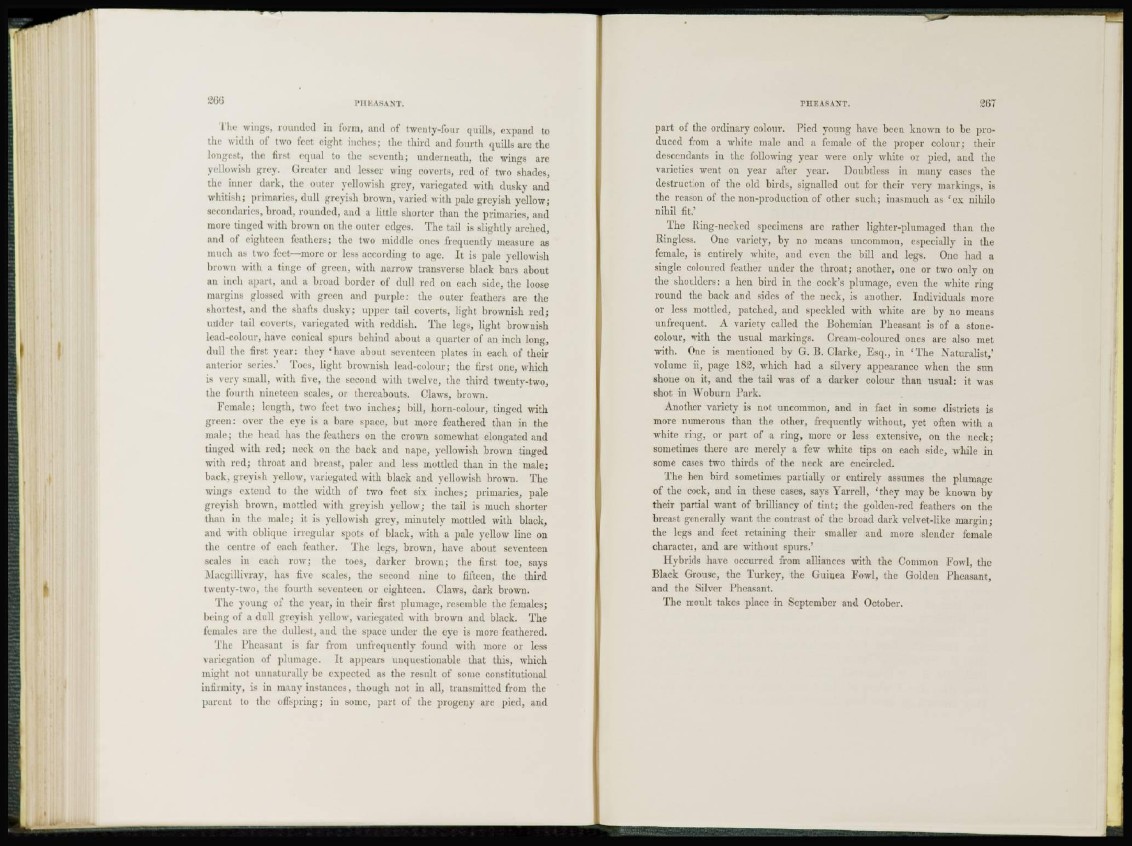
The wings, rounded iu form, and of twenty-four quills, expand to
the width of two feet eight inches; the third and fourth quills are the
longest, the first equal to the seventh; underneath, the wings are
yellowish grey. Greater and lesser wing coverts, red of two shades,
the inner dark, the outer yellowish grey, variegated with dusky and
whitish; primaries, dull greyish brown, varied with pale greyish yellow;
secondaries, broad, rounded, and a little shorter than the primaries, and
more tinged with brown on the outer edges. The tail is slightly arched,
and of eighteen feathers; the two middle ones frequently measure as
much as two feet—-more or less according to age. It is pale yellowish
brown with a tinge of green, with narrow transverse black bars about
an inch apart, and a broad border of dull red on each side, the loose
margins glossed with green and purple: the outer feathers are the
shortest, and the shafts dusky; upper tail coverts, light brownish red;
under tail coverts, variegated with reddish. The legs, light brownish
lead-colour, have conical spurs behind about a quarter of an inch long,
dull the first year: they 'have about seventeen plates in each of their
anterior s e r i e s . ' Toes, light brownish lead-colour; the first one, which
is very small, with five, the second with twelve, the third twenty-two,
the fourth nineteen scales, or thereabouts. Claws, brown.
Female; length, two feet two inches; bill, horn-colour, tinged with
green: over the eye is a bare space, but more feathered than in the
male; the head has the feathers on the crown somewhat elongated and
tinged with red; neck on the back and nape, yellowish brown tinged
with red; throat and breast, paler and less mottled than in the male;
back, greyish yellow, variegated with black and yellowish brown. The
wings extend to the width of two feet six inches; primaries, pale
greyish brown, mottled with greyish yellow; the tail is much shorter
than in the male; it is yellowish grey, minutely mottled with black,
and with oblique irregular spots of black, with a pale yellow line on
the centre of each feather. 'The legs, brown, have about seventeen
scales in cacti row; the toes, darker brown; the first toe, says
Macgillivray, has five scales, the second nine to fifteen, the third
twentv-two, the fourth seventeen or eighteen. Claws, dark brown.
The young of the year, in their first plumage, resemble the females;
being of a dull greyish yellow, variegated with brown and black. The
females are the dullest, and the space under the eye is more feathered.
The Pheasant is far from unfrequently found with more or less
\ a negation of plumage. It appears unquestionable that this, which
might not unuaturally be expected as the result of some constitutional
infirmity, is in many instances, though not in all, transmitted from the
parent to the oifspring; iu some, part of the progeny are pied, and
part of the ordinary colour. Pied young have been kuown to be produced
from a white male and a female of the proper colour; their
descendants in the following year were only white or pied, and the
varieties went on year after year. Doubtless in many cases the
destruction of the old birds, signalled out for their very markings, is
the reason of the non-production of other such; inasmuch as ' c x nihilo
nihil fit.'
The Iling-necked specimens arc rather lightcr-plumaged than the
Ringless. One variety, by no means uncommon, especially in the
female, is entirely white, and even the bill and legs. One had a
single coloured feather under the throat; another, one or two only on
the shoulders: a hen bird in the cock's plumage, even the white ring
round the back and sides of the neck, is another. Individuals more
or less mottled, patched, and speckled with white are by no means
unfrequcnt. A variety called the Bohemian Pheasant is of a stonecolour,
with the usual markings, ('ream-coloured ones are also met
with. One is mentioned by G. B. Clarke, Esq., in ' T h e Naturalist,'
volume ii, page 182, which had a silvery appearance when the sun
shone on it, and the tail was of a darker colour than usual: it was
shot in Woburn Park.
Another variety is not uncommon, and in fact in some districts is
more numerous than the other, frequently without, yet often with a
wdiite ring, or part of a ring, more or less extensive, on the neck;
sometimes there are merely a few white tips on each side, wliilc in
some cases two thirds of the neck are encircled.
The hen bird sometimes partially or entirely assumes the plumage
of the cock, and in these cases, says Yarrell, 'they may be known by
their partial want of brilliancy of tint; the golden-red feathers on the
breast generally want the contrast of the broad dark velvet-like margin;
the legs and feet retaining their smaller and more slender female
character, and are without spurs.'
Hybrids have occurred from alliances with the Common Fowl, the
Black Grouse, the Turkey, the Guinea Fowl, the Golden Pheasant,
and the Silver Pheasant.
The moult takes place in September and October.